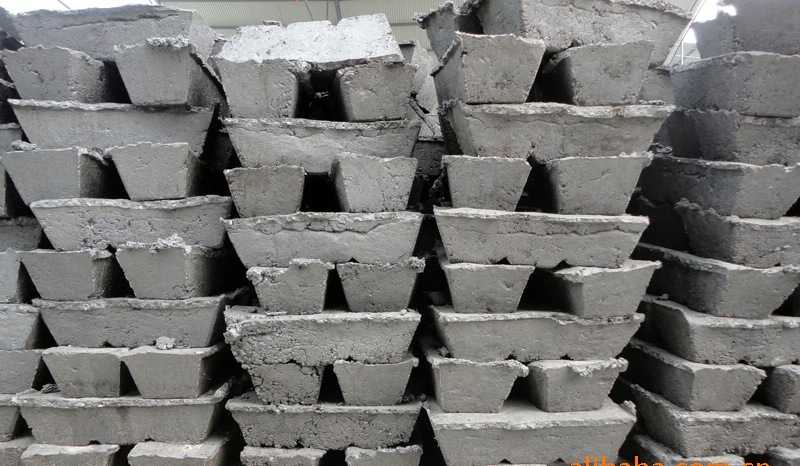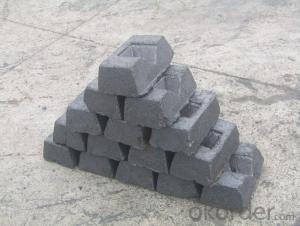Sealing Carbon Electrode Paste
- Loading Port:
- China Main Port
- Payment Terms:
- TT OR LC
- Min Order Qty:
- 20
- Supply Capability:
- 1000 /month
OKorder Service Pledge
OKorder Financial Service
You Might Also Like
Introduction:
Carbon Electrode Paste is a self-baking electrode used in submerged arc furnaces for delivering power to the charge mix. Electrode Paste is added to the top of the electrode column in either cylindrical or briquette form. As the paste moves down the electrode column the temperature increase causes the paste to melt and subsequently bake forming a block of electrically conductive carbon. Electrode Paste is essentially a mix of Electrically Calcined Anthracite (ECA) or Calcined Petroleum Coke (CPC) with Coal Tar Pitch.
•Main Function And Features
1) Low ash content
2) Good electric and thermal conductivity
3) High resistance to temperature
4) Stable quality
5) Reasonable price
6) Size:all kinds of electrode paste
7) Accord customer's reques change
Specification:
S/N | Sealing paste | Chemically Electrode Paste | |
Item | No.1 | No.2 | |
Ash.( % ) | 4.0 max | 6.0 max | 11.0 max |
V.M (%) | 12.0-15.5 | 12.0-15.5 | 11.5-15.5 |
Compress Strength. (Mpa) | 18.0 min | 17 min | 19.6 min |
Specific Resistance (μΩm) | 65 max | 7568 max | 90 max |
Bulk Density (G/CM3) | 1.38 min | 1.38 min | 1.38 min |
Elongation % | 5-20 | 5-20 | 5-25 |
PICTURE:

- Q:Does iron have more carbon or more steel?
- Iron has a high carbon contentThe main difference is that the pig iron, wrought iron and steel carbon content, carbon content of more than 2% of iron is iron;
- Q:Carbon emissions trading stocks latest list of carbon emissions trading stocks what?
- Carbon trading concept of a total of 21 listed companies, of which 12 carbon trading concept listed companies trading on the Shanghai Stock Exchange, and 9 other carbon trading concept listed companies trading in the Shenzhen stock exchange.Automatic matching based on the cloud financial leading excavator, carbon trading stocks leading shares most likely from the following stock was born in Tianke, electrical, environmental protection up to confidence.
- Q:What is the role of carbon in the formation of diamonds?
- The role of carbon in the formation of diamonds is essential, as diamonds are composed entirely of carbon atoms arranged in a crystal lattice structure. The extreme heat and pressure deep within the Earth's mantle cause carbon atoms to bond tightly together, forming the unique structure of a diamond. Without carbon, diamonds would not exist.
- Q:How is activated carbon produced?
- Activated carbon is created by a process known as activation, which involves heating carbon-rich materials (such as wood, coal, or coconut shells) at high temperatures without oxygen. Activation can be done in two main ways: physically or chemically. In physical activation, the carbon-rich material is first carbonized by heating it to a high temperature. This creates a char with a high carbon content. Then, an oxidizing gas (like steam or carbon dioxide) is used to treat the char at temperatures ranging from 600 to 900 degrees Celsius. This causes the char to expand and develop a porous structure. The resulting material is washed and dried to eliminate any impurities, resulting in activated carbon. On the other hand, chemical activation involves saturating the carbon-rich material with a chemical activating agent (such as phosphoric acid, zinc chloride, or potassium hydroxide). The impregnated material is then heated to temperatures between 400 and 800 degrees Celsius. This process chemically reacts with the carbon, forming a porous structure. The activated carbon is washed and dried to remove any remaining chemicals. Both physical and chemical activation methods yield activated carbon with a large surface area and a network of pores. These pores enhance the adsorption capacity of the activated carbon, enabling it to effectively capture and eliminate impurities, contaminants, and pollutants from gases and liquids.
- Q:I just decoration, do not understand, JS run, please feel free to show.
- LED gold tube Yuba, tinghuo... Carbon fiber was a real fire last year
- Q:What is carbon dating and how does it work?
- The age of organic materials, like wood, cloth, and bone, can be determined using carbon dating, a scientific method. This method measures the quantity of carbon-14 (C-14) present in the sample. It is based on the principle that all living organisms contain a small amount of radioactive carbon-14, which is created in the upper atmosphere when nitrogen atoms are hit by cosmic rays. Over time, this radioactive form of carbon decays and transforms into nitrogen-14. To begin the process of carbon dating, a sample is collected from the object of interest. Typically, this sample consists of organic matter that was once part of a living organism. The sample is then treated to remove any impurities and made ready for analysis. Scientists measure the ratio of C-14 to stable carbon-12 (C-12) in the sample to determine its age. This measurement is carried out using an accelerator mass spectrometer (AMS), an instrument with high sensitivity that can detect and measure extremely low levels of C-14. By comparing the ratio of C-14 to C-12 in the sample with the known ratio in the atmosphere at the time the organism died, scientists can calculate the time that has passed since the organism's death. The half-life of C-14, which is the time it takes for half of the radioactive isotope to decay, is approximately 5,730 years. This means that after 5,730 years, half of the C-14 in a sample will have transformed into nitrogen-14. By measuring the remaining amount of C-14 in a sample and knowing its half-life, scientists can estimate its age. Carbon dating is an invaluable tool for archaeologists, paleontologists, and geologists as it enables them to accurately determine the age of ancient artifacts, fossils, and geological formations. However, it is important to note that carbon dating is effective only for materials up to around 50,000 years old since beyond this point, the remaining amount of C-14 becomes too small to measure accurately.
- Q:What are the impacts of carbon emissions on coral reefs?
- Carbon emissions have significant impacts on coral reefs. One of the most significant consequences is the process of ocean acidification, caused by the absorption of excess carbon dioxide (CO2) from the atmosphere. As the ocean becomes more acidic, coral reefs struggle to build and maintain their calcium carbonate skeletons, essential for their structure and survival. This can lead to reduced growth rates and weakened reefs, making them more susceptible to damage from storms, disease, and other stressors. Additionally, the rising ocean temperatures resulting from carbon emissions have led to widespread coral bleaching events. When corals experience prolonged exposure to high temperatures, they expel the symbiotic algae (zooxanthellae) living within their tissues, which provide them with essential nutrients and give them their vibrant colors. Without these algae, corals become pale or completely white, a phenomenon known as bleaching. If the stressors subside, corals can recover, but if the bleaching is severe or prolonged, it can lead to coral death and the subsequent degradation of the reef ecosystem. Furthermore, increased carbon emissions contribute to the intensification of storms and other extreme weather events, which pose a direct threat to coral reefs. Stronger storms can physically damage the reefs, breaking apart their fragile structures and reducing their resilience. The resulting sediment runoff from land, often exacerbated by storms, can smother corals and hinder their ability to feed and grow. The impacts of carbon emissions on coral reefs are not only detrimental to these diverse marine ecosystems but also to the millions of people who depend on them for food, income, and coastal protection. Coral reefs support a vast array of marine life, provide a source of livelihood for many communities through fishing and tourism, and act as natural barriers against storm surge and coastal erosion. The degradation of coral reefs due to carbon emissions threatens the livelihoods and well-being of these communities, as well as the overall health and biodiversity of our oceans. To mitigate these impacts, it is essential to reduce carbon emissions by transitioning to cleaner, renewable energy sources, promoting sustainable practices on land to reduce runoff and pollution, and implementing effective management and conservation measures to protect and restore coral reef ecosystems.
- Q:What are the impacts of carbon emissions on marine life?
- Carbon emissions have significant impacts on marine life. The release of carbon dioxide into the atmosphere leads to ocean acidification, which disrupts the balance of pH levels in the water. This affects the ability of marine organisms to build and maintain their shells or skeletons, particularly in coral reefs and mollusks. Additionally, rising temperatures due to carbon emissions contribute to coral bleaching, leading to the loss of crucial habitats and biodiversity. Furthermore, increased carbon dioxide levels can alter the behavior, reproduction, and growth rates of various marine species, ultimately impacting the entire marine ecosystem.
- Q:What is carbon offsetting in aviation?
- Carbon offsetting in aviation refers to the practice of compensating for the greenhouse gas emissions produced by aircraft by investing in projects that reduce or remove an equivalent amount of carbon dioxide from the atmosphere. This voluntary measure aims to mitigate the environmental impact of air travel by supporting initiatives such as renewable energy projects or reforestation efforts.
- Q:How does carbon affect the properties of steel?
- Carbon affects the properties of steel by increasing its hardness, strength, and overall durability. The presence of carbon allows for the formation of iron carbides, which strengthen the steel's crystal lattice structure. The higher the carbon content, the harder and stronger the steel becomes. However, excessive carbon can make the steel brittle, reducing its impact resistance.
1. Manufacturer Overview |
|
|---|---|
| Location | |
| Year Established | |
| Annual Output Value | |
| Main Markets | |
| Company Certifications | |
2. Manufacturer Certificates |
|
|---|---|
| a) Certification Name | |
| Range | |
| Reference | |
| Validity Period | |
3. Manufacturer Capability |
|
|---|---|
| a)Trade Capacity | |
| Nearest Port | |
| Export Percentage | |
| No.of Employees in Trade Department | |
| Language Spoken: | |
| b)Factory Information | |
| Factory Size: | |
| No. of Production Lines | |
| Contract Manufacturing | |
| Product Price Range | |
Send your message to us
Sealing Carbon Electrode Paste
- Loading Port:
- China Main Port
- Payment Terms:
- TT OR LC
- Min Order Qty:
- 20
- Supply Capability:
- 1000 /month
OKorder Service Pledge
OKorder Financial Service
Similar products
New products
Hot products
Related keywords



























